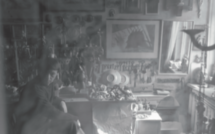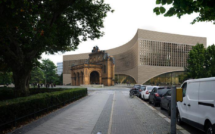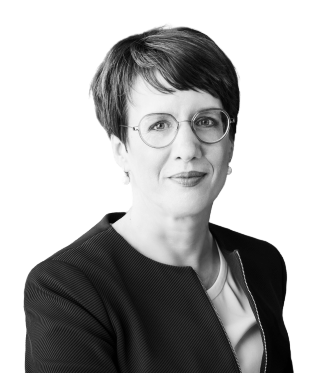

This is part of our special feature, Displacement, Memory, and Design.
After the collapse of Communism in 1989, the city of Berlin, just ten years later, again became the capital of a newly, re-unified Germany. Much attention has been paid to the move of the German government from Bonn to Berlin. But this move and the unification of Germany after more than forty years of division also necessitated a rethinking of Germany’s history. While Germans after division into East and West following the Second World War remained one nation, the creation of two separate German states also meant that two profoundly differing narratives of history and Germany’s most recent past—the period of National Socialism—were created. The move to Berlin and the unification of Germany thus necessitated a serious reengagement with the country’s past. The rich landscape of Berlin’s Museums and Memorial sites has been part of this coming to terms with the crimes of Germans during the Nazi period.
Maria Höhn (Vassar College) and Nicole Shea (Council for European Studies) spoke with Gundula Bavendamm about Berlin’s latest museum that is part of this coming to terms with this difficult German past. Bavendamm, the former Director of the Allied Museum, Berlin has been the Director of the Bundesstiftung Flucht, Vertreibung, Versöhnung (Flight, Expulsion, Reconciliation), and its affiliated documentation center since 2016. The museum opened this past summer to educate and commemorate the expulsion of almost 14 million Germans at the end of WWII. It seeks to put that history within the larger context of National Socialist policies in the East and the crises of forced displacement today.
—Maria Höhn and Nicole Shea for EuropeNow
EuropeNow The Documentation Center for Displacement, Expulsion, Reconciliation considers itself a place of remembrance for about 14 million German refugees, who lost their home after the Second World War, but also a place for those who are fleeing war and expulsion now. In her address, Angela Merkel said that the new Center “fills a gap in our coming to terms with history.” And yet, it took until 2021 to make the project a reality. Why could this Center not be realized earlier and why was it controversial for so long to integrate the history and memory of the expulsion of fourteen million Germans after WWII?
Gundula Bavendamm Societies dealing with complex, conflicting, and painful aspects of their history often need decades, if not generations, to integrate those chapters into their commemorative culture. This has also been true for Germany. Finding an appropriate form to commemorate the experiences of those 14 million Germans who fled from the advancing Soviet military or were forcibly expelled as part of the Allied WWII and post-WWII treaties has indeed taken nearly twenty years. The process of how to remember and commemorate has been particularly difficult because of Germany’s responsibility for the Second World War, the Shoah, and the unprecedented crimes committed by Germans against soldiers and civilians on the Eastern Front. It is that history that has been central to how Germans have been dealing with WWII and its aftermath. The debates around the creation of the Center, especially in the early 2000s, focused on the question of whether the representation of the history of displacement and expulsion of the Germans, of German victimhood, is legitimate given German crimes of the past and the country’s enduring responsibility for those crimes. In short: can perpetrators also be victims? On a more academic level, the discussion focused on how such a narrative could be represented without relativizing Germany’s crimes of the past. One of the most intensely debated questions was therefore to what extent, and how, the core subject needed to be contextualized. On the one hand, certain aspects of the history of National Socialism, such as its own forced population transfer plans, needed to be narrated in order to provide the necessary historical context for the expulsion of the Germans as a result of WWII. On the other hand, a much broader European and global narrative on Forced Migrations was needed to illustrate that the expulsion of the Germans was just one among many other population groups that had to suffer displacement and expulsion in the twentieth Century.
EuropeNow How has your own background and professional experience influenced your vision for the Center and how does it differ from your predecessors?
Gundula Bavendamm As a historian I brought my academic expertise in contemporary German and European history to the project, my skills as a professional exhibition curator, and my management experience as the former director of the Allied Museum in Berlin. Besides, I’m from a family where history and politics have always been discussed. With my team, I aimed first of all to create a narrative respecting the founding mission and spirit of the Documentation Center which is to document and commemorate the expulsion of the Germans at the end of the Second World War and their suffering with empathy. A second important guideline for us was to be clear about the historical causality: that the expulsion of the Germans was a direct consequence of National Socialist ideology and the criminal warfare Germans conducted in the East. It was important to us to organize the narrative spatially in such a way that this connection couldn’t be ignored or avoided by visitors. That led us to the decision to create a narrative in two parts on two distinct levels of the building. On the ground floor, a comprehensive view of twentieth century expulsions and displacements invites the visitor to choose freely among six themes to learn more about this history. On the second floor, an in-depth narrative chronologically leads and illustrates for the visitor how Germans were first expellers and then themselves became expellées during WWII. We also wanted a narrative which can convincingly connect with relevant questions of today and even universal experiences since displacement and expulsion, unfortunately, are the painful reality for millions of people around the world.
Another important reason for the narrative we have chosen is our educational mission. One of our key tasks is to make the expulsion of Germans during and after WWII, and of forced migrations in general, relevant to young people. When today’s teenagers hear about displacement, very few, if any, will think about East Prussia or Silesia in 1945 but rather about the refugee crisis of our times or the diverse backgrounds of their classmates who have made a new home in Germany. We believe that especially the breadth and depth of the first part of the permanent exhibit offers an excellent platform to foster this much-needed dialogue with younger generations but also with visitors from abroad—often with experiences of displacement and expulsion themselves. When it comes to the founding mission, I consider this carefully balanced narrative the “handwriting” of my team and me, explicit in terms of the historical causality of why Germans were expelled and open to contemporary phenomena.
EuropeNow Are you worried that, as some critical voices have suggested, that the Center’s “mixing” of refugee destinies and their causes of flight force viewers to compare something that is incomparable, thereby distracting from the lasting responsibility for the German crimes of World War II and the murder of European Jews. What made you and the curators decide to portray these refugee destinies side-by-side?
Gundula Bavendamm The deeply researched and careful contextualization of that expulsion, and the embedding of the expulsion of Germans within the pre-history of expulsions committed during the Nazi regime is key to our narrative. To illustrate that connection between German crimes in the Second World War and what came in the aftermath of that war, has always been the key task of this institution. It is in fact part of the founding law of this institution. Most important is that we don’t want to, and, in my opinion, actually don’t compare. On the contrary: everywhere in this exhibition and in our communications we make clear that genocide is something different than the expulsion of a population group. In that sense the German experiences at the end of the Second World War obviously can’t be “compared.” But one can’t deny that in history boundaries of analysis can and often are fluent. The Genocide of Europe’s Jews began as an expulsion. The first group of German expellees were the German Jews who were driven out of the German Reich by means of discrimination, persecution and dispossession. And if you take the experiences of the German expellees at the end of the Second World war, the methods of internment and expulsion by the new governments especially in Eastern and South Eastern Europe were partially very brutal, leading to very high death rates. In some of those cases the line between expulsion and genocidal practices is not always easy to draw. Finally, there is the question of forced displacement and Human Rights. While acknowledging the difference between genocide and expulsion, our institution acknowledges that not only a genocide but also the enforcement of displacement and the planning and execution of expulsions are violations of Human Rights. This is also true for German civilians affected by that experience at the end of the Second World War.
EuropeNow There are more refugees than ever worldwide and forced migration will remain a global pressing issue, as the recent developments in Afghanistan make very clear. How can the Center position itself as a historical and contemporary voice with lasting impact?
Gundula Bavendamm Our core task is to document phenomena of contemporary history informed by academic standards and to foster a deeper understanding why the twentieth century became a century of displacement and expulsion on such an unprecedented scale. But the way the exhibition is narrated makes our institution also a great resource and locale to participate in contemporary discussions related to displacement in all its forms. Especially the first part of our permanent exhibit is a good starting point for such conversations and exchanges. But your question also gives me the opportunity to focus on the third component of the Center’s name. The main point of reference for the Documentation Center is not activism but reconciliation (Versöhnung). We certainly have the ambition to become a forum for lively and also difficult discussions. But in those debates, our role is not so much to take sides but to open a space for an open exchange that takes into account various opinions as long as they are expressed within the framing and the values of the German Basic Law.
EuropeNow The TAZ* mentions that the average age of the Center’s visitors is sixty and up. Could you envision this center also as a place where younger generations of Germans can engage not only with their country’s difficult past but also with the ethical and moral challenges of displacement today?
Gundula Bavendamm The TAZ expressed its opinion very shortly after the opening of the Documentation Center. Not surprisingly, many older people came in the beginning, often with a family history of displacement and expulsion during and after the Second World War—among them were numerous donors of artefacts to the exhibit or to our growing collection. Many of those representatives of the so called “Erlebnisgeneration” had been waiting for the opening of the Center for many years. This group of early visitors, who lived through the expulsion, is important to us, but also their family members of the second, third or even fourth generation who accompanied them. But another target group for us is today’s youth, and one of our main tasks in the coming months and years therefore is to reach out to schools and teachers and thus to make this place relevant to a new generation of young Germans. We have been most pleased with our efforts so far, even as we continue to expand our network of educators. The number of school classes coming to us has already risen since the opening. Age wise, we now have a much more mixed audience than before.
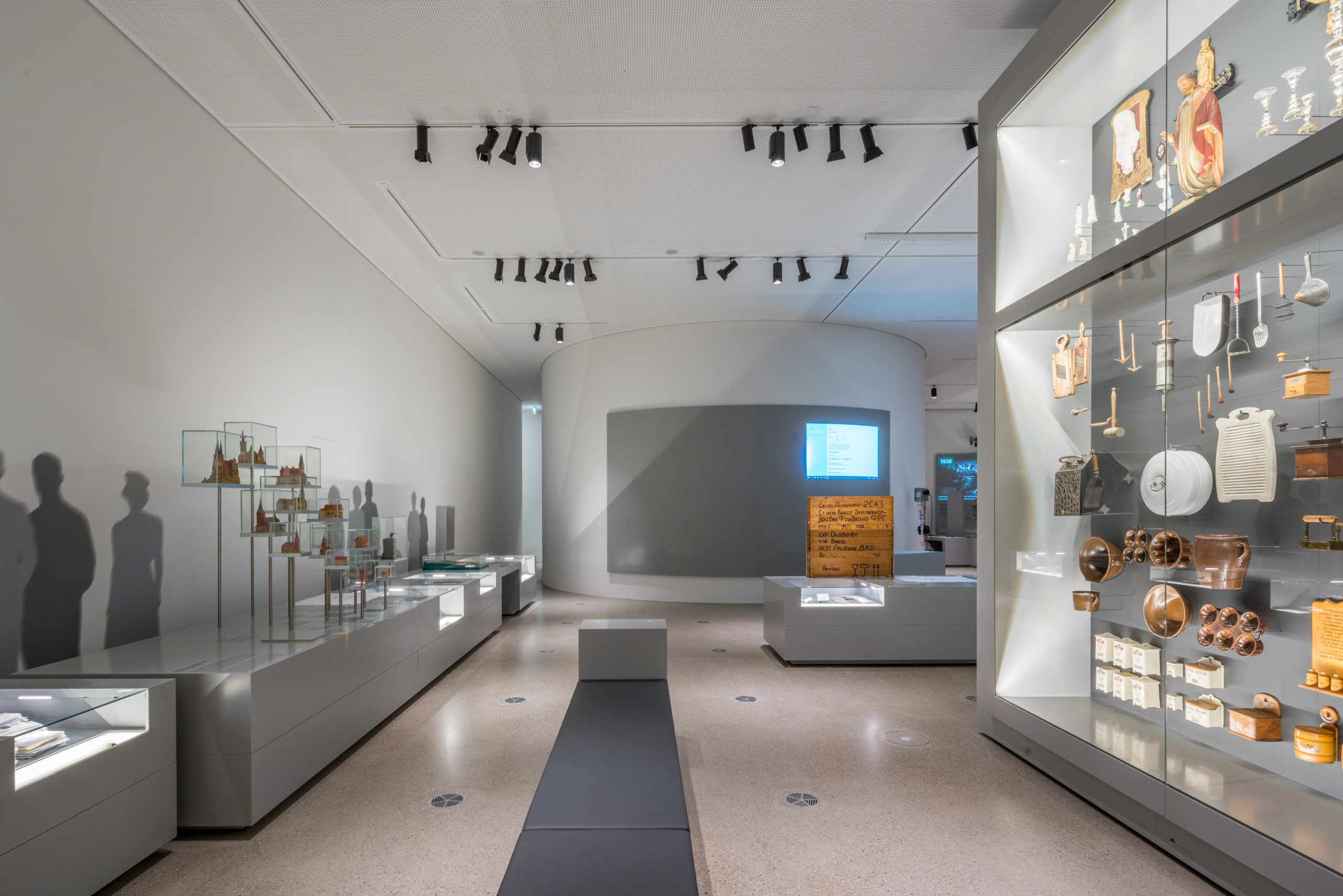
EuropeNow The Center portrays the integration of the 2015 refugees into German society as a success story. Not everyone would agree, among them Erika Steinbach, former CDU-representative and president of the “Bund der Vertriebenen” (BdV), who initiated the idea for a Center together with SPD-politician Peter Glotz in 1999. How can the Zentrum manage what appears to be a careful balancing act between “wir schaffen das” and 2015 was a success, and the exhibition that illustrates that real integration and true arrival in a new home, takes generations?
Gundula Bavendamm I don’t agree that we portray the integration of the 2015 refugees into German society as a success. In the first part of the permanent exhibit, we focus on personal experiences and rather subjective perspectives of some of the refugees of 2015, for example from Syria. We show their dangerous routes, their often-long sojourns in camps of all sorts, the uncertainty of their life situations once they have arrived in a foreign society. At the very end of the second part of the permanent exhibit we present a chronology over a time span of thirty years since the Fall of the Iron Curtain. One picture among many shows Chancellor Merkel with a refugee in 2015 which has indeed become iconic and represents that spirit of “Wir schaffen das.” The tonality of the text coming with it is neutral, I think.
Indeed, throughout the exhibition, whenever we explore the subject of integration on a historical level, the emphasis is on how complex the process is and how long it can take to cope with displacement and expulsion on an individual level. In the first part of the exhibit, for instance, experts speak about traumatic experiences that can overshadow lives for generations. Especially the interviews with eyewitnesses invite the viewer to reflect on the challenge of coping with material and immaterial losses coming with displacement and expulsion and what it takes to make home anew far from home.
EuropeNow This is a special issue on Forced Migration/Displacement and Design. Can you say something about the choices that were made for the building? To which degree have architects perhaps considered the input from the public or scholars who are conceptualizing the narration and shape of the exhibition?
Gundula Bavendamm To my knowledge there was not any deliberate effort to gather input from the public or scholars in the redesign of the building. One aspect which was important to the Austrian architects Marte.Marte is transparency, and that is achieved on the first floor with two huge panoramic windows that open our building to the neighborhood, which is home to other sites of commemoration. The architects have thus created a visible connection between the commemoration of the expulsion of the Germans at the end of the Second World War with the context of Germany’s National Socialist past. On one side our building is open to the important Documentation Center, the Topography of Terror, which details the bureaucracy and institutions responsible for implementing the Holocaust. On the opposite side of our Center, looking out from our Library, the visitor can see the ruin of the historical Anhalter Bahnhof. This architectural reminiscence will, if all goes according to plan, serve as the entrance point for the planned Exilmuseum. This new site will commemorate the history of those Germans who were forced to flee abroad after the Nazis came to power. Anhalter Bahnhof was also the site from where elderly German Jews were deported to Terezin.
In general, I would note that the building’s history demonstrates that the idea of “form follows function” has become less influential during the last two decades or so, at least with regard to buildings which are designed to serve cultural needs. Often in competitions the reputational gain through grand architectural gestures seems to be valued higher than the functionality of the building needed to fulfil its cultural mission. The panoramic windows, for example, are beautiful but we had to permanently close them with a semi-transparent curtain in order to protect the exhibits on the first floor. Also, certain aspects of the technical infrastructure limited the creative scope of the exhibition designer who joined the project only later in the process.
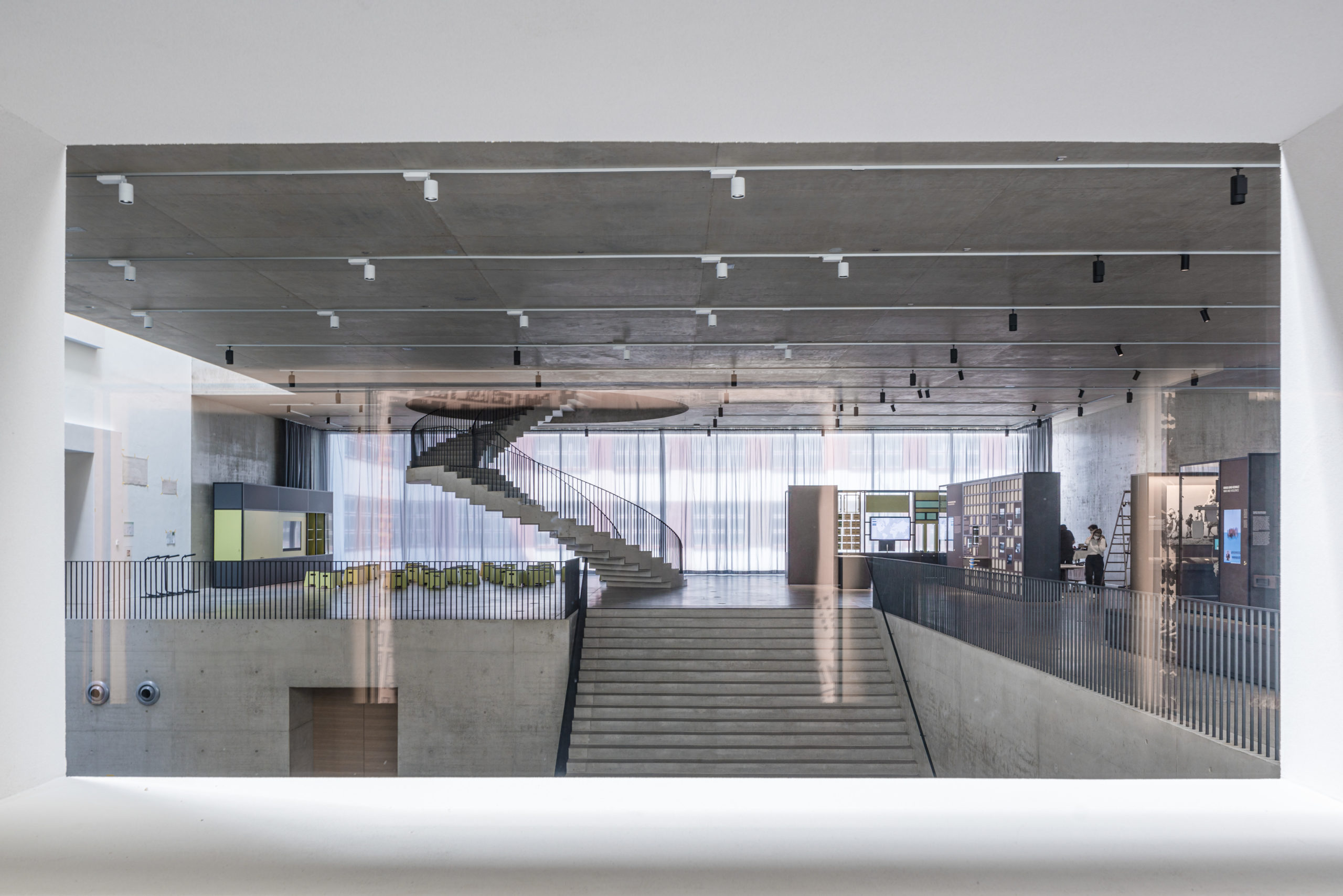
EuropeNow Right across the street from your house will be the Museum of Exile. Do you see any tensions between the different memories in these two spaces, or do you see untold possibilities of future collaboration?
Gundula Bavendamm I see great potential and, in that spirit, I have been in touch with the team of the Exilmuseum for more than two years now. In the Documentation Center, the expulsion and exile of German Jews who were able to escape from Germany is not a focus. Therefore, to have this new museum in the immediate neighborhood is particularly valuable. From an institutional point of view, but particularly from a visitor and tourist point of view, the Documentation Center Displacement, Expulsion, Reconciliation, the Topography of Terror and, hopefully soon, the Exilmuseum, complement one another and permit viewers to learn about German postwar history from different perspectives. Together, they will offer a unique insight into the ambivalences of history in general and of German history in particular.
Maria Höhn is Professor of History on the Marion Musser Lloyd ‘32 Chair, Vassar College, and Director and PI of the Consortium on Forced Migration, Displacement, and Education.
Nicole Shea is the Director of the Council for European Studies at Columbia University and the Executive Editor of EuropeNow.
* TAZ article “Fallen vermieden, Irritation bleibt.” June 26, 2021

